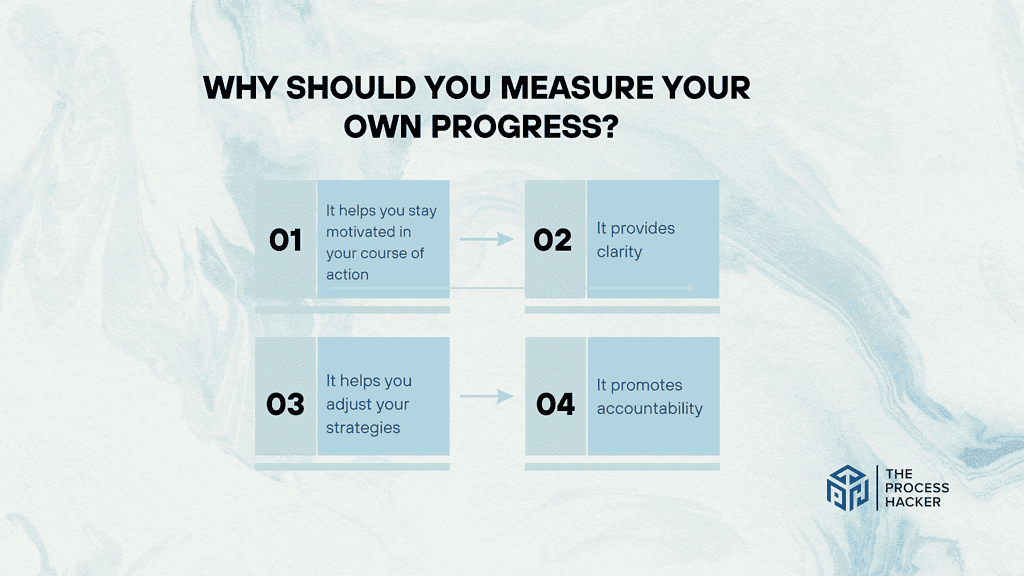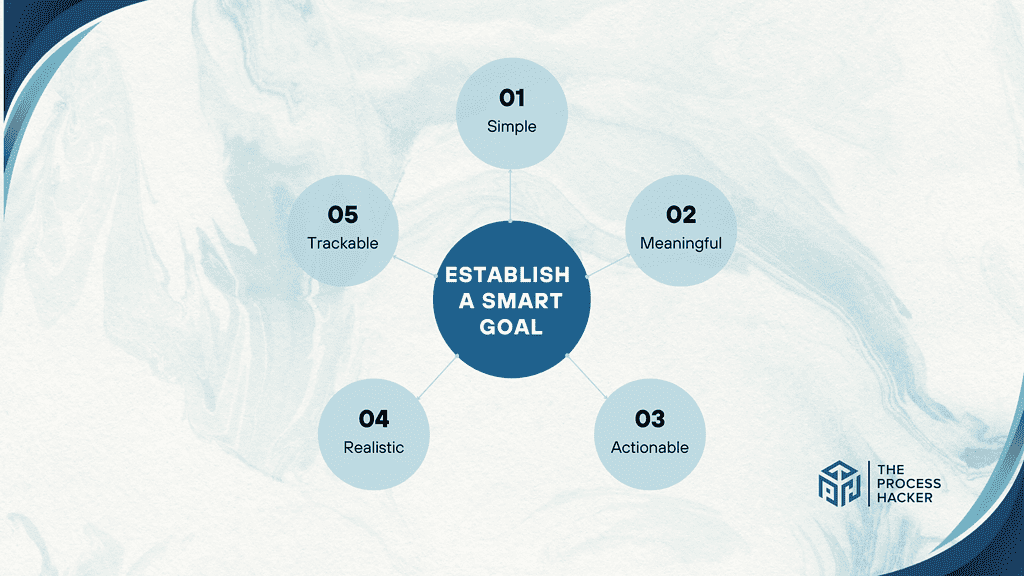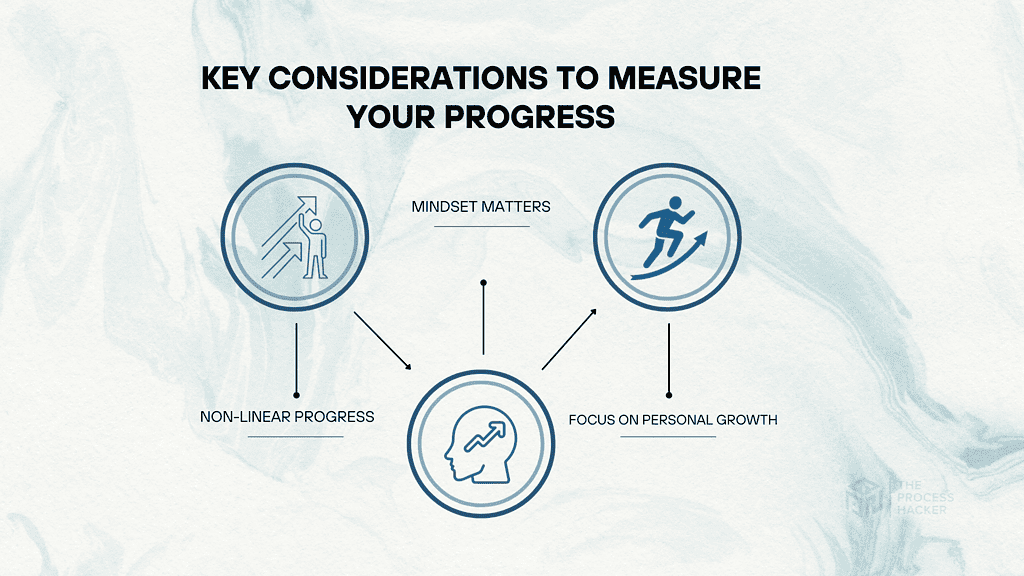How to Measure Progress Towards Goals
Struggling to make progress on your goals? Time is slipping by, and maybe you are not seeing any real progress towards your goals.
Stop because you don’t have to keep going in circles anymore. In this post, I will help you measure the right things so that each step will bring you closer to success.
Learn how to easily track your progress to get clarity and confidence when pursuing any goal while saving time that would otherwise be spent on guesswork.
My techniques break down challenging objectives into manageable chunks, making progress and setting realistic expectations much simpler.
Don’t wait any longer – start making serious headway on your major goals!
What Does It Mean to Measure Your Progress?
When measuring progress, I’m referring to assessing incremental gains toward a set goal. This involves tracking specific metrics or indicators that give tangible evidence of how far you’ve come and how much further you need to go. It’s about taking stock of where you are and where you want to be in the future.
Why Should You Measure Your Own Progress?

Measuring your progress is critical for personal growth and success. Without it, you might feel like you’re merely drifting aimlessly. By tracking your progress, you gain a clear sense of direction and purpose.
Here’s why this skill is essential and relevant:
- It helps you stay motivated in your course of action: Seeing tangible evidence of your progress can boost your motivation and keep you focused on your goals.
- It provides clarity: Tracking your progress gives you a clear picture of where you stand concerning your goals.
- It helps you adjust your strategies: If you’re not progressing, you can change your strategy and tactics accordingly.
- It promotes accountability: When you measure your progress, you hold yourself accountable for achieving your goals.
Seeing the importance of how to measure progress, you might wonder how to do it effectively. That’s where my method comes into play. I’ll guide you through a practical approach to check your progress and make the journey toward your goals a rewarding experience.
How To Measure Your Progress
Now that we’ve established the importance of measuring your progress let’s dive into how you can do it. It may seem daunting at first, but trust me, once you get the hang of it, it will become a crucial part of your journey towards achieving your goals. Let’s break it down into manageable steps.
Establish a SMART Goal

The first baby step to measure progress is to ensure that the specific goal is defined as a SMART goal. An exciting, audacious goal will help you get motivated, make more progress, and make it easier to measure how much progress is made.
In Start Finishing (book summary), Charlie Gilkey states that we have to take our ideas and define them as SMART goals in the following framework:
- Simple – “help you know exactly what you need to do to move forward with your great idea.”
- Meaningful – provides you with a quick understanding of “the importance of completing that goal.”
- Actionable – tells you “what action needs to be taken to accomplish that goal.”
- Realistic – shows you that “the endpoint is achievable with the resources you have available.”
- Trackable – tells you clearly “what progress means,” qualitatively or quantitatively; needs to establish start and end dates, or it will not happen.
Taking the time to set long-term goals with a defined outcome carefully can make a massive difference in the execution of your next project or business venture. Remember to make your short and long-term goals a stretch, but be realistic when setting targets – setting wildly unrealistic expectations can set you up for failure before you start!
Crafting SMART goals ensures you have clarity around what is expected from the project so that everyone involved knows what success looks like.
Examples of Goal Setting in the SMART way:
- Marketing Example: “I will create and post three blog posts per week to increase traffic by 20% on my website in the second quarter of the year.”
- Sales Example: “I will close 30 customers at $3K each to earn $90K in sales, which is an increase of $15K from the past month, in February.”
- Fulfillment Example: “I will complete writing my 250-page book during the year’s third quarter.”
- Personal Example: “I will gain the necessary skills and experience in my current role to make a successful career change into hospitality by the age of 28.”
Set a Deadline
When setting goals, it’s vital to spell out precisely what you aim to achieve and the timeline for doing so. In this context, deadlines become critical for tracking progress and realizing your objectives. With set deadlines and your time management skills, you can lose accountability and veer off course or get distracted from the task at hand.
Deadlines keep you anchored to your objectives, promoting active progression towards your goals as you strive to meet the established timeline. They bring structure to your plan and help you delineate the scope and timeframes for the effort needed to turn those aspirations into tangible outcomes.
By assigning deadlines, you create a benchmark to complete tasks, instilling a sense of responsibility in yourself or your team to take the necessary steps to fulfill your set objectives. The ticking clock adds an element of pressure that can serve as a motivator, spurring further progress and propelling you toward meeting those deadlines. This, in turn, assists in achieving the overarching goal.
However, when faced with the constant pressure and tight deadlines, it can be tempting, for example, to pay to write essay or skip a class. But it’s important to strike a balance between getting things done while maintaining quality. By rising to the challenge and adhering to deadlines, you will become more resilient and disciplined, which helps you to be more successful in the long-term.
Break Your Larger Goal Down into Smaller Goals
If we focus solely on the grand scheme, we might be daunted by the magnitude of work that awaits. Hence, once you have a deadline set for your goal, it’s beneficial to divide a larger, more intricate plan into smaller, manageable milestones or tasks:
- A milestone refers to an action or event that signifies a substantial change or phase in the evolution of your primary goal.
- On the other hand, a task is a single piece of work that must be undertaken to pursue your main objective.
Consequently, dissecting goals into attainable tasks allows you to make incremental progress in the desired direction. Set milestones and carry out SMART tasks – Specific, Meaningful, Actionable, Realistic, and Trackable – and can be accomplished within specified timeframes.
Completing a milestone or task fuels motivation and enhances your ability to check progress more efficiently. Achieving milestones and tasks as part of a larger goal instills confidence and provides tangible evidence of your progress.
You’ll gain a clearer understanding of where you stand on your journey to success from the reference point, so when you finally reach your goal, you can bask in the satisfaction you’ve achieved.
Take Action on the Lead Measures
When working towards a goal, focusing solely on the outcome is tempting. However, to truly measure your progress and increase your chances of success, you must pay attention to the lead measures. But what are lead measures?
Lead measures are the actions you take that will directly influence the achievement of your goal. They are predictive, meaning they significantly impact your goal, and they are influenceable, meaning you can do something about them. Conversely, lag measures result from your lead measures that you cannot control directly.
For example, if your goal is to lose weight, your lead measures might be the number of calories you consume daily or the amount of exercise you do each week. The lag measure is the weight that you record from stepping on the scale.
So, how do you execute this step?
- Step 1: Identify what your lead measures are. Think about the actions that will have the most significant impact on your goal. This might require research or input from others who have achieved similar goals.
- Step 2: Set targets for these lead measures. These should be realistic, achievable, and challenging enough to drive you towards your goal.
- Step 3: Track your progress. Keep a record of your actions and regularly review your progress. Are you meeting your targets? If not, what changes do you need to make? Remember, the aim here isn’t just to hit your targets but to use them as a powerful tool to guide you towards your ultimate goal.
Focusing on your lead measures will give you a clearer sense of your progress and be more likely to achieve your goals. After all, it’s the actions we take each day that ultimately determine our success.
Create a Compelling Scoreboard To Track Progress
In your journey to goal completion, just taking action is not enough. You need a way to track and measure your progress visually. That’s where the concept of a compelling scoreboard comes into play.
A compelling scoreboard is a visual tool that helps you keep track of your lead measures (the actions you take that directly influence the achievement of your goal). It’s a powerful motivator because it gives you a clear picture of where you stand with your plan.
You must decide what data to track to develop and utilize this scoreboard. This should directly relate to your lead measures. For example, if you want to read more books, your data points could be the number of pages or chapters read daily.
You also need to design your scoreboard. It should be simple and easy to understand at a glance. You can use a whiteboard, a spreadsheet, or a goal-tracking app – choose whatever works best for you.
Then, make it a habit to update your scoreboard regularly – daily if possible. This will give you immediate progress feedback and help you stay motivated.
Finally, review and analyze your scoreboard periodically. Are you on track to achieve your goal? If not, what adjustments do you need to make?
Remember, the purpose of this scoreboard isn’t just to record data. It’s there to provide you with a visual representation of your journey, to inspire action, and to motivate you to achieve your goal. So make sure your scoreboard is somewhere you’ll see it often!
By creating a compelling scoreboard, you’re not just keeping track of your progress – you’re actively motivating yourself to move closer to your daily goals.
Measure and Review Progress Regularly
Measuring your progress and reviewing it regularly to target your goals is crucial. This step ensures that you’re on the right track and allows you to make necessary adjustments in your approach.
Establishing a regular review schedule helps a lot. Depending on your goal, this could be a daily, weekly, or monthly review. For example, if you want to write a book, you should review your progress daily. A weekly review might be more appropriate if your life goal is to lose weight.
During each review, look at the data on your scoreboard regularly. Are you meeting your targets? Are you consistently taking the actions (your lead measures) that will move you closer to your overall goal?
Don’t forget to reflect on your life progress. Celebrate your wins, no matter how small they may seem. Acknowledging your accomplishments can boost your motivation and keep you focused on your goal.
However, it’s also important to identify any areas where you fall short. If you need to meet your targets, try to understand why and improve going forward. Do you need to adjust your actions? Or are your targets too ambitious and need to be revised?
Finally, based on your review, make any necessary adjustments. Remember that changing your approach is okay if something isn’t working. The key is to stay flexible and adaptable.
By measuring and reviewing your progress regularly, you can ensure that you’re moving in the right direction and that your efforts are leading you toward your goal. After all, what gets measured gets managed, and what gets managed gets done!
Key Considerations To Measure Your Progress

Key considerations must be remembered as you measure your progress toward your goals. Here are the key concerns you should have in mind:
- Non-linear progress: Understand that progress isn’t always linear. There will be peaks and troughs, but the overall forward movement matters.
- Mindset matters: Your perception of your progress can significantly impact your motivation. Try to maintain a positive, growth-oriented attitude, viewing challenges as opportunities rather than setbacks.
- Focus on personal growth: While tracking numbers is important, remember your personal growth and experiences gained along the journey. The real victory lies beyond the numbers.
Taking it to the Next Level: Check Your Daily Progress
If you’re ready to enhance your progress tracking, check your progress daily. This lets you stay closely connected with your goals and quickly identify deviations from your planned path.
Start by setting aside a few minutes at the end of each day to reflect on what you’ve accomplished toward your life, career, and work goals. What actions did you take? What results did you achieve? This daily check-in can be as simple as journaling notes or ticking off tasks on your to-do list.
Furthermore, day-to-day progress checks can foster a sense of achievement and momentum. Each day that you see yourself moving closer to your goal, no matter how small the step, can boost your motivation and commitment. Over time, these daily wins accumulate, leading to significant progress towards your goal.
Remember, it’s not just about reaching the finish line but also enjoying the journey. By checking your daily progress, you’ll become more aware of every step toward your goal, making the journey as rewarding as the destination.
Final Thoughts on Measuring Progress
Wrapping up, it’s crucial to understand that measuring progress toward your goals is not just about ticking off tasks on a checklist. It’s about recognizing your growth, celebrating the small victories, and understanding that progress isn’t always a straight line.
Measuring progress towards goals is essential for any manager looking to achieve success in their role.
By setting realistic targets and tracking performance against them regularly, managers can ensure they stay on track with their goals and adjust as needed.
With patience and perseverance, measuring your progress toward goals can help managers reach their objectives more efficiently and effectively!















